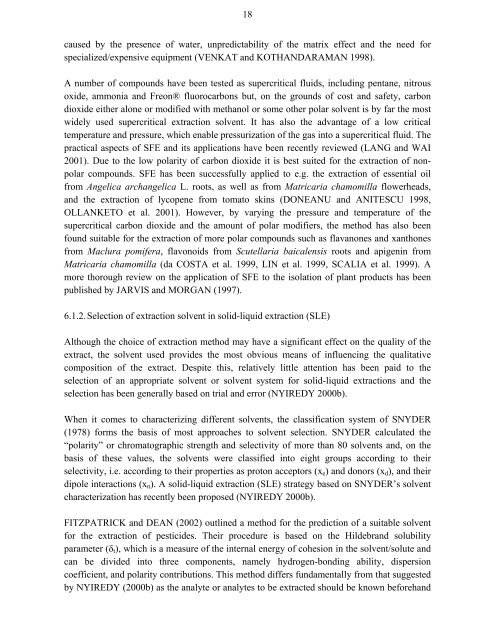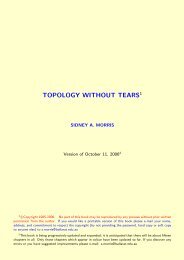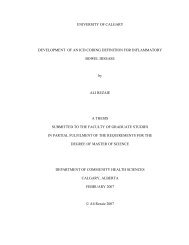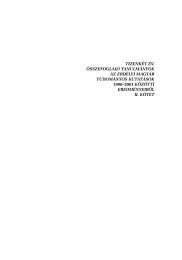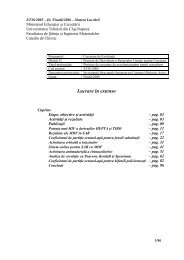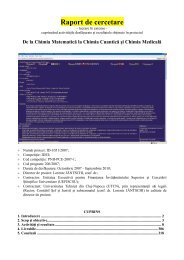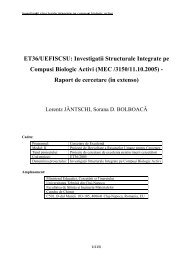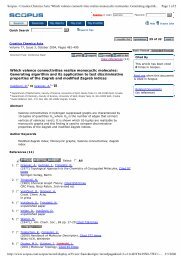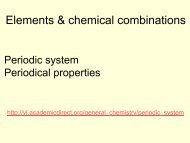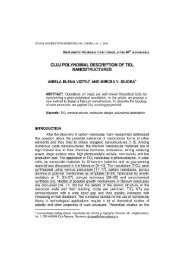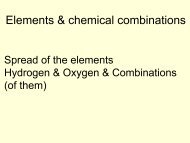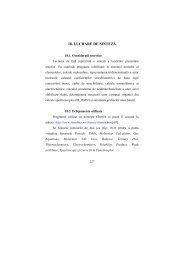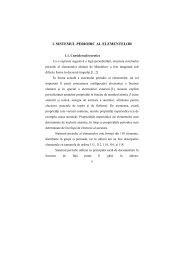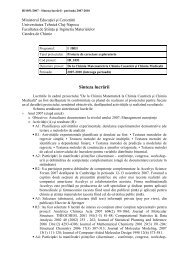Extraction and Planar Chromatographic Separation Techniques in the
Extraction and Planar Chromatographic Separation Techniques in the
Extraction and Planar Chromatographic Separation Techniques in the
Create successful ePaper yourself
Turn your PDF publications into a flip-book with our unique Google optimized e-Paper software.
18<br />
caused by <strong>the</strong> presence of water, unpredictability of <strong>the</strong> matrix effect <strong>and</strong> <strong>the</strong> need for<br />
specialized/expensive equipment (VENKAT <strong>and</strong> KOTHANDARAMAN 1998).<br />
A number of compounds have been tested as supercritical fluids, <strong>in</strong>clud<strong>in</strong>g pentane, nitrous<br />
oxide, ammonia <strong>and</strong> Freon® fluorocarbons but, on <strong>the</strong> grounds of cost <strong>and</strong> safety, carbon<br />
dioxide ei<strong>the</strong>r alone or modified with methanol or some o<strong>the</strong>r polar solvent is by far <strong>the</strong> most<br />
widely used supercritical extraction solvent. It has also <strong>the</strong> advantage of a low critical<br />
temperature <strong>and</strong> pressure, which enable pressurization of <strong>the</strong> gas <strong>in</strong>to a supercritical fluid. The<br />
practical aspects of SFE <strong>and</strong> its applications have been recently reviewed (LANG <strong>and</strong> WAI<br />
2001). Due to <strong>the</strong> low polarity of carbon dioxide it is best suited for <strong>the</strong> extraction of nonpolar<br />
compounds. SFE has been successfully applied to e.g. <strong>the</strong> extraction of essential oil<br />
from Angelica archangelica L. roots, as well as from Matricaria chamomilla flowerheads,<br />
<strong>and</strong> <strong>the</strong> extraction of lycopene from tomato sk<strong>in</strong>s (DONEANU <strong>and</strong> ANITESCU 1998,<br />
OLLANKETO et al. 2001). However, by vary<strong>in</strong>g <strong>the</strong> pressure <strong>and</strong> temperature of <strong>the</strong><br />
supercritical carbon dioxide <strong>and</strong> <strong>the</strong> amount of polar modifiers, <strong>the</strong> method has also been<br />
found suitable for <strong>the</strong> extraction of more polar compounds such as flavanones <strong>and</strong> xanthones<br />
from Maclura pomifera, flavonoids from Scutellaria baicalensis roots <strong>and</strong> apigen<strong>in</strong> from<br />
Matricaria chamomilla (da COSTA et al. 1999, LIN et al. 1999, SCALIA et al. 1999). A<br />
more thorough review on <strong>the</strong> application of SFE to <strong>the</strong> isolation of plant products has been<br />
published by JARVIS <strong>and</strong> MORGAN (1997).<br />
6.1.2.Selection of extraction solvent <strong>in</strong> solid-liquid extraction (SLE)<br />
Although <strong>the</strong> choice of extraction method may have a significant effect on <strong>the</strong> quality of <strong>the</strong><br />
extract, <strong>the</strong> solvent used provides <strong>the</strong> most obvious means of <strong>in</strong>fluenc<strong>in</strong>g <strong>the</strong> qualitative<br />
composition of <strong>the</strong> extract. Despite this, relatively little attention has been paid to <strong>the</strong><br />
selection of an appropriate solvent or solvent system for solid-liquid extractions <strong>and</strong> <strong>the</strong><br />
selection has been generally based on trial <strong>and</strong> error (NYIREDY 2000b).<br />
When it comes to characteriz<strong>in</strong>g different solvents, <strong>the</strong> classification system of SNYDER<br />
(1978) forms <strong>the</strong> basis of most approaches to solvent selection. SNYDER calculated <strong>the</strong><br />
“polarity” or chromatographic strength <strong>and</strong> selectivity of more than 80 solvents <strong>and</strong>, on <strong>the</strong><br />
basis of <strong>the</strong>se values, <strong>the</strong> solvents were classified <strong>in</strong>to eight groups accord<strong>in</strong>g to <strong>the</strong>ir<br />
selectivity, i.e. accord<strong>in</strong>g to <strong>the</strong>ir properties as proton acceptors (xe) <strong>and</strong> donors (xd), <strong>and</strong> <strong>the</strong>ir<br />
dipole <strong>in</strong>teractions (xn). A solid-liquid extraction (SLE) strategy based on SNYDER’s solvent<br />
characterization has recently been proposed (NYIREDY 2000b).<br />
FITZPATRICK <strong>and</strong> DEAN (2002) outl<strong>in</strong>ed a method for <strong>the</strong> prediction of a suitable solvent<br />
for <strong>the</strong> extraction of pesticides. Their procedure is based on <strong>the</strong> Hildebr<strong>and</strong> solubility<br />
parameter (δt), which is a measure of <strong>the</strong> <strong>in</strong>ternal energy of cohesion <strong>in</strong> <strong>the</strong> solvent/solute <strong>and</strong><br />
can be divided <strong>in</strong>to three components, namely hydrogen-bond<strong>in</strong>g ability, dispersion<br />
coefficient, <strong>and</strong> polarity contributions. This method differs fundamentally from that suggested<br />
by NYIREDY (2000b) as <strong>the</strong> analyte or analytes to be extracted should be known beforeh<strong>and</strong>


